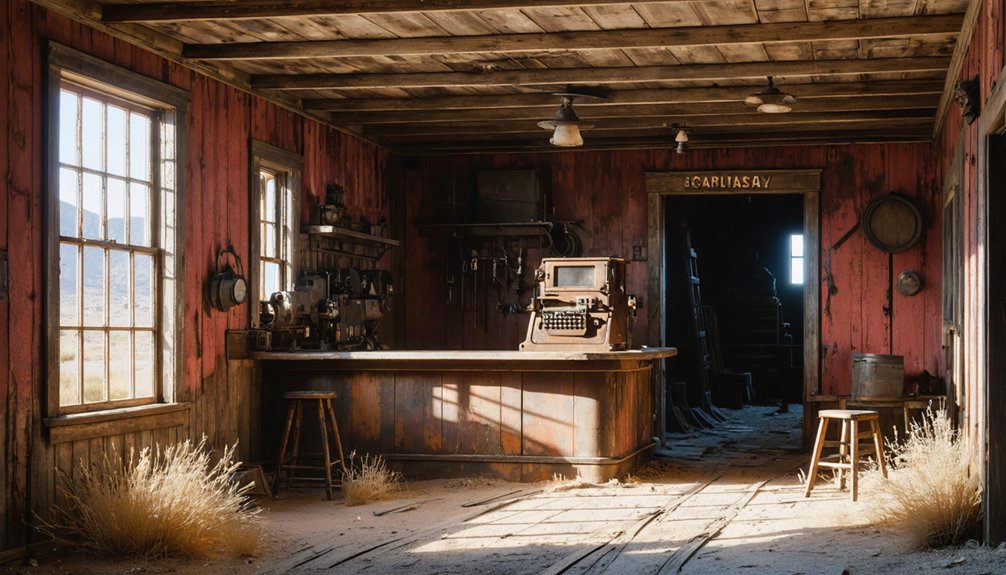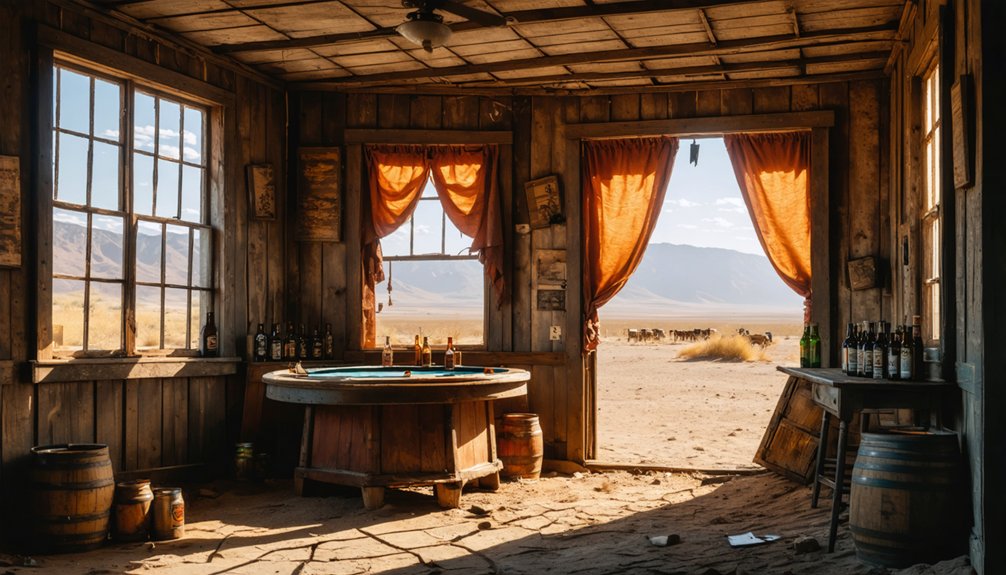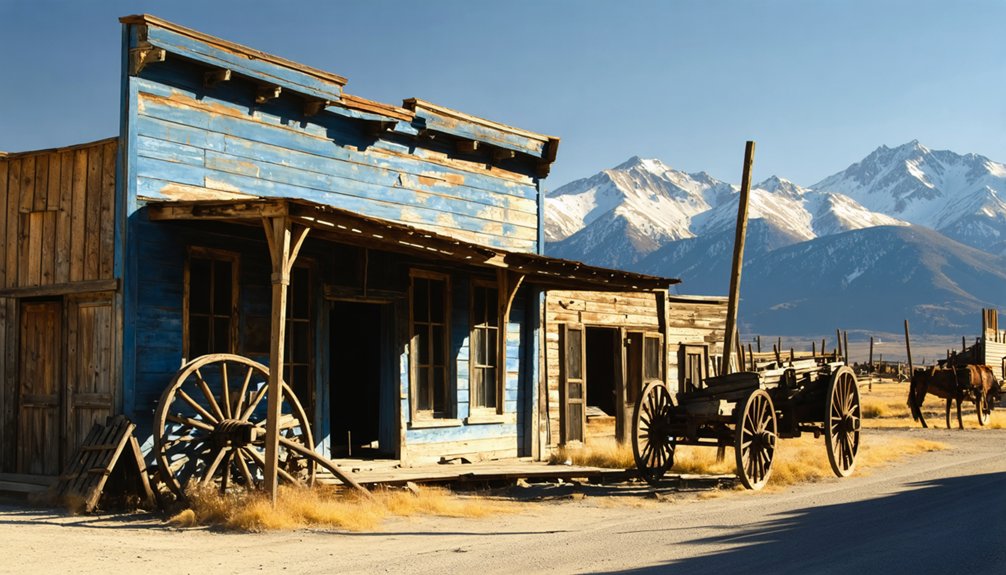Western ghost towns like Bodie and Saint Elmo offer windows into America’s boom-and-bust mining history. You’ll find these abandoned settlements preserved through methods ranging from “arrested decay” to full restoration. Their fates were sealed by resource depletion, economic collapse, and railroad abandonment. Today, these weathered remnants generate tourism revenue while challenging communities to balance authenticity with accessibility. The stories etched in their crumbling walls reveal much more than empty buildings and forgotten dreams.
Key Takeaways
- Ghost towns across the Western US, particularly in Texas and California, serve as reminders of past mining and oil booms.
- “Arrested decay” preserves ghost towns like Bodie State Historic Park in their weathered state, maintaining historical authenticity.
- Tourism transforms abandoned towns into visitor destinations, generating revenue for preservation efforts while supporting local economies.
- Rail networks determined the fate of many Western settlements, with ghost towns often emerging where railroads bypassed communities.
- Preservation efforts face challenges from rising property taxes, over-commercialization, and the need to balance tourism with authenticity.
The Rise and Fall of Bodie: California’s Frozen-in-Time Mining Marvel
Although it began with inauspicious origins, Bodie emerged as one of the West’s most extraordinary mining boomtowns following W.S. Bodey’s discovery of gold in 1859. The prospector never witnessed his namesake’s glory, perishing in a blizzard before Bodie’s meteoric rise.
When miners struck a major deposit in 1876, the sleepy camp exploded into a raucous frontier metropolis. You’d find yourself amid 8,000 souls by 1879, traversing a landscape of 65 saloons, gambling halls, and brothels.
Bodie’s mining legacy earned miners $4 daily—exceptional wages then. The town’s notorious reputation for lawlessness earned it the phrase “Badman from Bodie” by 1880.
In Bodie’s golden heyday, miners pocketed $4 daily—a princely sum that drew fortune-seekers to this rugged boomtown.
The boom couldn’t last. By 1912, decline began with the newspaper’s final issue, followed by the Standard Consolidated Mine’s 1913 closure. Winters were particularly brutal, with temperatures plummeting below 40 degrees zero, making survival a daily challenge.
Today, California preserves Bodie in “arrested decay,” maintaining its abandoned authenticity as the West’s best-preserved ghost town.
Belmont and Saint Elmo: Tales of Silver Dreams and Mountain Isolation
When you examine Nevada’s Belmont and Colorado’s Saint Elmo, you’ll notice how silver mining booms created economic prosperity that vanished once resources depleted and rail services were abandoned.
The 1876 Belmont courthouse and Saint Elmo’s well-preserved structures at 9,600 feet elevation demonstrate how different environments affect preservation trajectories.
These high-altitude remnants face unique conservation challenges from harsh weather patterns and remote locations, requiring specialized approaches to maintain their historical integrity. Today’s visitors to Belmont can still explore the old miner cabins and mill sites while experiencing a completely off-grid environment without modern amenities. The town’s silver production generated approximately $15 million worth of silver during its peak period from the 1860s to the 1880s.
Silver Economy Impacts
The silver economies of the American West created explosive patterns of boom and bust that forever altered the landscape through the rise and fall of mining communities.
You’ll find this dramatic economic volatility perfectly illustrated in Belmont and Saint Elmo, where silver mining transformed tent camps into thriving settlements with thousands of residents virtually overnight.
When examining these ghost towns today, you’re witnessing the physical manifestation of a precarious economy tied to a single commodity.
Saint Elmo once bustled with activity as the Mary Murphy Mine produced between 50-75 tons of ore daily during its heyday.
Silver’s demonetization sent both communities into tailspins—Belmont collapsing as workers fled to richer Tonopah mines, while Saint Elmo suffered from the devastating Panic of 1893.
The abandoned courthouse in Belmont and the deteriorating storefronts of Saint Elmo stand as symbols to freedom’s inherent risk—fortunes made and lost on the whims of mineral wealth.
Colonel Buell’s mill in Belmont extracted an impressive $100,000 in silver bullion from local ore, showcasing the immense but fleeting wealth that defined these mining towns.
Rail Abandonment Effects
Railroad abandonment sealed the fate of numerous mining communities across the western frontier, with Saint Elmo and Belmont illustrating how transportation infrastructure directly determined a settlement’s viability.
When the Denver, South Park and Pacific Railroad removed their tracks from Saint Elmo in 1926, they severed the town’s economic lifeline.
You’ll notice the stark correlation between railroad infrastructure withdrawal and population collapse—Saint Elmo’s 2,000 residents in 1890 dwindled to just seven by 1930.
This pattern of economic dependency repeated throughout the West. As railroads abandoned unprofitable routes, communities lost their ability to export minerals and import necessities.
Saint Elmo’s history as a once-thriving community is now preserved within academic studies of Delta Phi fraternities who document abandoned western settlements.
The conversion of Saint Elmo’s rail grade into a road from Nathrop couldn’t halt the exodus, demonstrating how deeply these isolated mountain communities relied on efficient rail connections for survival. Like Newhouse, which featured a modern railroad and depot, these transportation hubs were essential to maintaining viable western settlements.
High-Altitude Preservation Challenges
Situated at breathtaking elevations above 7,000 feet, both Belmont and Saint Elmo face preservation challenges unique to high-altitude environments that accelerate their structural decline.
The relentless freeze-thaw cycles you’ll witness at these elevations rapidly deteriorate wooden structures and crack foundations, while high UV exposure intensifies material breakdown.
Saint Elmo’s 10,000-foot perch subjects it to brutal winters with snow blocking access for months, complicating any high altitude preservation efforts. Saint Elmo’s designation as a national historic district in 1979 has attracted significant preservation efforts from Buena Vista Heritage and the State Historical Fund.
Meanwhile, Belmont’s remaining brick and stone structures tell tales of community resilience through their endurance, despite the salvaging of timber by departing residents.
The isolation that once forged tightly-knit mining communities now hinders preservation work, with limited infrastructure making it difficult to deploy modern conservation technologies in these remote mountain settings. Like Animas Forks sitting precariously at over 11,200 feet, these towns demonstrate the extreme conditions under which Colorado’s mining history unfolded.
Preservation Methods: From “Arrested Decay” to Full Restoration
When you visit ghost towns preserved through “arrested decay,” you’ll encounter authentic structural remnants maintained in their weathered state rather than reconstructed to appear new.
This preservation philosophy prioritizes historical integrity by implementing only essential stabilization measures, as seen in Bodie, California, where buildings retain their natural aging patterns.
In contrast, fully restored sites like Calico Ghost Town offer a more curated, tourist-ready experience where structures have been rebuilt using period-appropriate materials to recreate the town’s appearance during its heyday.
“Arrested Decay” Philosophy
Among the various approaches to ghost town preservation, “arrested decay” stands as a distinctive philosophy that carefully balances historical authenticity with structural stability.
You’ll find this method exemplified at Bodie State Historic Park, where California officials coined the term. Unlike full restoration, arrested decay prevents further deterioration while maintaining each structure’s weathered appearance. At Bodie, only essential repairs—roof maintenance, foundation stabilization—are performed, preserving the site exactly as it stood in 1962.
Similarly, at Garnet Ghost Town, the Bureau of Land Management applies minimal interventions, focusing on preventing collapse rather than rebuilding. This approach costs considerably—Bodie’s annual preservation budget reaches $2.3 million—but delivers an unparalleled authentic experience.
When you visit these sites, you’re witnessing history frozen in time, not recreated for tourism.
Authentic vs. Tourist-Ready
The contrast between authentic historical preservation and tourist-oriented restoration represents a fundamental tension in ghost town management across the Western United States.
You’ll find this authenticity debate embodied in places like Bannack, Montana, where weathered structures stand alongside carefully restored buildings—creating a hybrid preservation model that balances historical integrity with visitor experience.
When you visit fully restored sites like Calico Ghost Town, you’re experiencing Walter Knott’s vision of the 1880s, meticulously recreated using period-accurate materials.
Meanwhile, community-led preservation efforts in places like Jerome, Arizona demonstrate how tourism balance affects preservation decisions. Local historical societies must weigh economic benefits against potential over-commercialization that threatens authentic character.
The choice between presenting genuine decay or tourist-ready restoration ultimately reflects competing values: historical accuracy versus economic sustainability.
Why They Were Abandoned: Resource Depletion and Economic Collapse

Resource exploitation formed the lifeblood of countless Western settlements that eventually became ghost towns, their ultimate abandonment inextricably linked to the finite nature of those resources.
Poor resource management and lack of economic resilience left these towns vulnerable when the inevitable occurred:
- Mining towns collapsed when gold, silver, or other mineral deposits became exhausted, leaving workers with no choice but to seek employment elsewhere.
- Company towns disappeared overnight when controlling corporations ceased operations.
- Single-industry economies proved fatally fragile when commodity prices plummeted.
- Environmental contamination from extraction activities rendered some areas uninhabitable.
When the mines closed, the railroads redirected, or industrial demand shifted, these once-vibrant communities couldn’t adapt quickly enough, leaving behind only weathered structures as evidence of their brief prosperity.
Ghosts of the Rails: How Transportation Shaped Town Destinies
Rail networks fundamentally determined the fate of countless Western settlements, serving as both lifelines and death sentences for frontier communities during America’s westward expansion.
You’ll find ghost towns scattered across the West where railroad routes bypassed once-promising settlements. Towns like Leadville thrived with rail connections while others withered in isolation. When the Baltimore & Ohio reached Grafton in the 1850s, it transformed from settlement to hub, demonstrating transportation’s transformative power.
Mining operations in places like Kennecott demanded extraordinary effort—four years of intensive labor—to connect remote locations to civilization.
These rail-dependent communities flourished briefly, then collapsed when resources depleted or services ceased. Saint Elmo’s population exodus directly followed the 1922 rail service termination, while Steins literally depended on railroads for water.
Transportation didn’t merely serve these towns; it determined their existence.
Beyond Buildings: The Cultural Legacy of Western Ghost Towns

While physical remnants of abandoned settlements dot the Western landscape, ghost towns have bequeathed far more than decaying structures—they’ve left profound cultural imprints that continue to shape regional identity today.
These settlements wove a cultural tapestry from diverse populations converging at economic frontiers, creating unique social dynamics that resonated beyond their brief existence.
- Indigenous displacement narratives challenge traditional ghost town romanticism, revealing complex histories of colonization beneath settler myths.
- Cultural melting pots where ethnic traditions merged and evolved, particularly in permissive environments like Beer City, Oklahoma.
- Tourism-driven preservation that balances authentic decay with interpretive experiences at sites like Bannack, Montana.
- Economic boom-bust cycles that forged distinctive regional identities now preserved through museums, festivals, and local folklore.
Photography and Art: Capturing the Haunting Beauty of Abandonment
The cultural impact of ghost towns extends beyond sociological narratives into visual representation, where photographers and artists have transformed these abandoned settlements into compelling subjects of aesthetic meditation.
When documenting these weathered remnants, you’ll achieve striking results using wide-angle lenses during golden hours, capturing both sweeping main streets and intimate details that tell forgotten stories.
Your composition techniques should include establishing shots followed by textural close-ups of weathered wood, rusted metal, and personal artifacts.
For more evocative storytelling approaches, experiment with black and white processing to emphasize temporal distance, or utilize long exposures at dawn and dusk.
A tripod becomes essential for interior documentation and low-light scenarios.
Remember to photograph responsibly—these fragile historical sites deserve preservation through your lens, not deterioration through careless interaction.
Planning Your Ghost Town Adventure: Seasonal Considerations

Planning your expedition to the West’s abandoned settlements requires careful consideration of seasonal variations, as timing dramatically affects both accessibility and experience quality.
Summer months offer ideal ghost town accessibility with dry roads and comfortable exploration conditions, while fall provides a perfect balance of mild weather and reduced crowds.
Summer welcomes ghost town explorers with optimal access, while autumn delivers the perfect blend of tranquility and comfort.
- June-August: Prime access period for most locations, particularly high-elevation towns like Bodie and Garnet that remain snowbound in colder months.
- September-November: Decreased tourism with pleasant temperatures and enhanced photographic conditions.
- March-May: Variable conditions with potential road challenges from snowmelt and mud.
- December-February: Limited access to most sites; some require specialized transportation like snowmobiles.
Always check specific town operating schedules before traveling, as seasonal weather patterns dictate opening dates, special events, and trail conditions throughout the Western frontier.
Economic Afterlife: How Abandoned Towns Fuel Modern Tourism
Once thriving centers of industry and commerce, Western ghost towns have found surprising economic resurrection through heritage tourism, transforming these abandoned settlements into lucrative visitor destinations.
Your exploration of these historical sites directly supports heritage preservation while creating sustainable local economies.
Texas and California lead with the highest concentration of ghost towns from mining and oil booms, where tourism now generates revenue for preservation efforts and infrastructure.
When you visit places like Terlingua, Texas, you’re participating in economic sustainability models that benefit small businesses and community services.
This revival isn’t without challenges—rising property taxes and over-commercialization threaten authenticity.
The most successful ghost towns balance visitor experiences with community engagement, ensuring tourism benefits locals while preserving the cultural significance that draws you there in the first place.
Frequently Asked Questions
Are Ghost Towns Legally Protected From Treasure Hunters and Collectors?
Text me this—treasure hunting laws protect ghost towns. You’ll face serious penalties for collecting artifacts. Historical site preservation regulations prohibit metal detecting and removal of even small objects from these legally protected areas.
Can You Still Claim Abandoned Property in Ghost Towns?
No, you can’t freely claim ghost town property without establishing legitimate property rights. Historical claims require proper title searches, legal ownership verification, and compliance with regulations governing abandoned structures.
What Supernatural Phenomena Have Been Documented in These Towns?
You’ll find documented apparitions, spectral miners’ lantern sightings, and unexplained footsteps throughout these towns. Ghost sightings in Bodie and St. Elmo have been confirmed through paranormal investigations, alongside curses affecting souvenir takers.
How Did Women’s Roles Differ in Mining Towns?
You’ll find women’s contributions extended beyond domestic roles into entrepreneurship, operating boarding houses and businesses while shaping social dynamics through community building, education, and mediating tensions in the rough mining environment.
Which Ghost Towns Are Accessible for People With Disabilities?
Calico and Bodie offer the best wheelchair pathways with paved streets, while South Pass City provides accessible tours. Bannack features some accessible buildings. Always check websites before your adventure for current accessibility information.
References
- https://explorethearchive.com/western-ghost-towns
- https://en.wikipedia.org/wiki/Wikipedia:WikiProject_Ghost_towns
- https://www.americansouthwest.net/ghost-towns.html
- https://m.dresshead.com/files/scholarship/Documents/Ghost_Towns_Lost_Cities_Of_The_Old_West_Shire_Usa.pdf
- https://www.geotab.com/ghost-towns/
- https://en.wikipedia.org/wiki/Ghost_town
- https://mwg.aaa.com/via/places-visit/western-ghost-towns
- https://bbb7.lpc.events/papersCollection/publication/fetch.php/Ghost Towns Of The West A Sunset Pictorial.pdf
- https://www.united.com/en/us/hemispheres/places-to-go/5-western-ghost-towns.html
- https://www.ghosttowns.com



